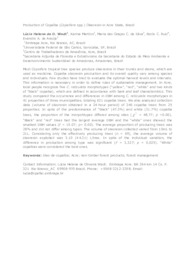Production of copaíba (Copaifera spp.) oleoresin in Acre State, Brazil.
Production of copaíba (Copaifera spp.) oleoresin in Acre State, Brazil.
Author(s): WADT, L. H. de O.; MARTINS, K.; SILVA, M. das G. C. da; RUIZ, R. C.; ARAÚJO, E. A. de
Summary: Most Copaifera tropical tree species produce oleoresins in their trunks and stems, which are used as medicine. Copaiba oleoresin production and its overall quality vary among species and individuals. Few studies have tried to evaluate the optimal harvest levels and intervals. This information is necessary in order to define rules of sustainable management. In Acre, local people recognize five C. reticulata morphotypes (?yellow?, ?red?, ?white? and two kinds of ?black? copaiba), which are defined in accordance with bark and leaf characteristics. This study compared the occurrence and differences in DBH among C. reticulata morphotypes in 41 properties of three municipalities, totaling 621 copaiba trees.
Publication year: 2008
Types of publication: Abstract in annals or event proceedings
Unit: Embrapa Acre
Keywords: Amazonia, Brasil, Óleo Essencial, Óleo de copaíba
Observation
Some of Embrapa's publications are published as ePub files. To read them, use or download one of the following free software options to your computer or mobile device. Android: Google Play Books; IOS: iBooks; Windows and Linux: Calibre.
Access other publications
Access the Agricultural Research Database (BDPA) to consult Embrapa's full library collection and records.
Visit Embrapa Bookstore to purchase books and other publications sold by Embrapa.

